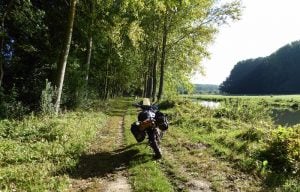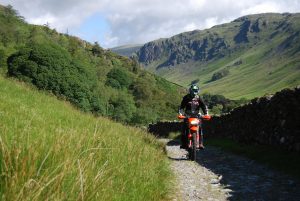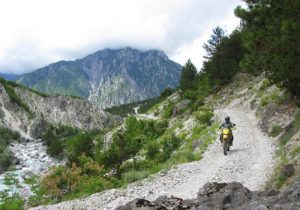Martin Litschauer and his wife Verena Kaiser-Litschauer ride stretches of the Trans Euro Trail through remote areas of Finland to Nordkapp, before motorcycling in Norway, on the wild Atlantic coast.
Heads down!” the loading master called out to us at the freight terminal of Vienna’s Central Railway Station. We’d ridden there that morning from our home in the city. At walking speed, Verena and I wobbled along the freight cars on our bikes.
We were reminded of the beginning of a previous trip we’d taken in Scotland, that mix of anticipation, excitement and nerves. Both of us stood at the platform and watched our motorcycles being lashed down on a train, marking the beginning of our new adventure.
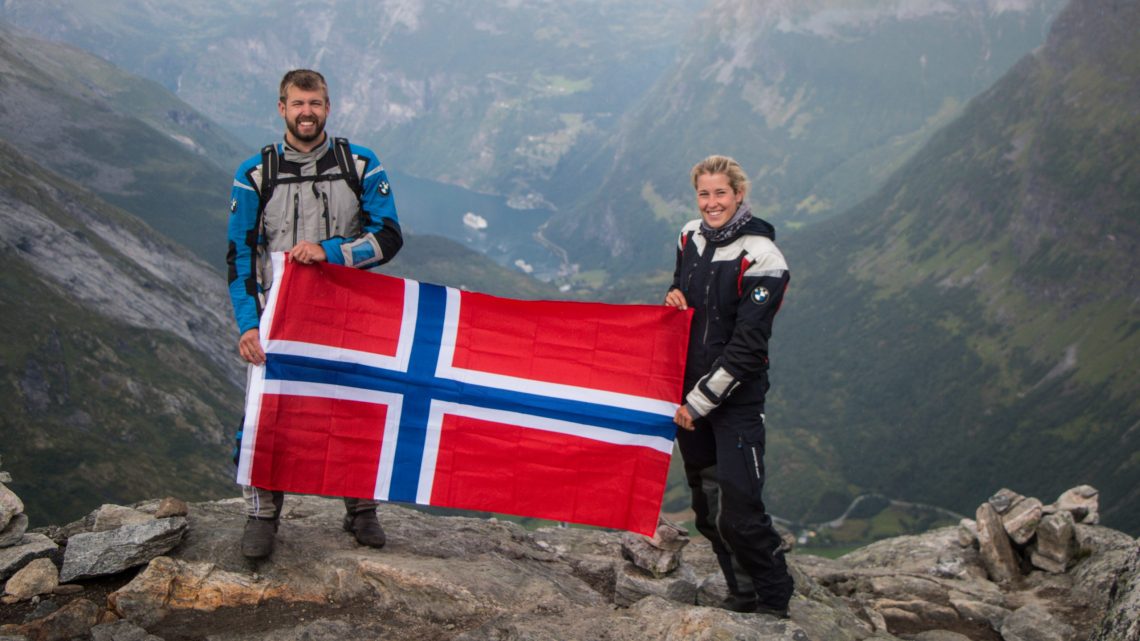
Nordkapp and back
Ahead lay four weeks of riding aboard our two BMW R1200 GS bikes. Our plan was to ride dirt roads and sections of the Trans Euro Trail north through Finland to Norway, where we would reach Nordkapp, the most northerly point in Europe you can ride to. We then planned to travel south west along Norway’s wild Atlantic coast, excited by the thought of riding through some of the most spectacular landscapes in the world. But first, we had to leave Austria and travel through Germany.
With a gentle knock on the cabin door, we were woken up punctually at 7am by the train attendant, arriving well rested in the German city of Hamburg. We already knew the city well from previous visits, so we skipped the sightseeing and had a leisurely breakfast instead.
While planning our trip, we decided to take the ferry from Travemünde, which is 55 miles away from Hamburg, to Helsinki in Finland. Therefore, we relaxed for the rest of the day at the promenade and stocked up on provisions for the two-day crossing of the Baltic Sea. The engines of the Finnstar ferry were already humming when we boarded at midnight.
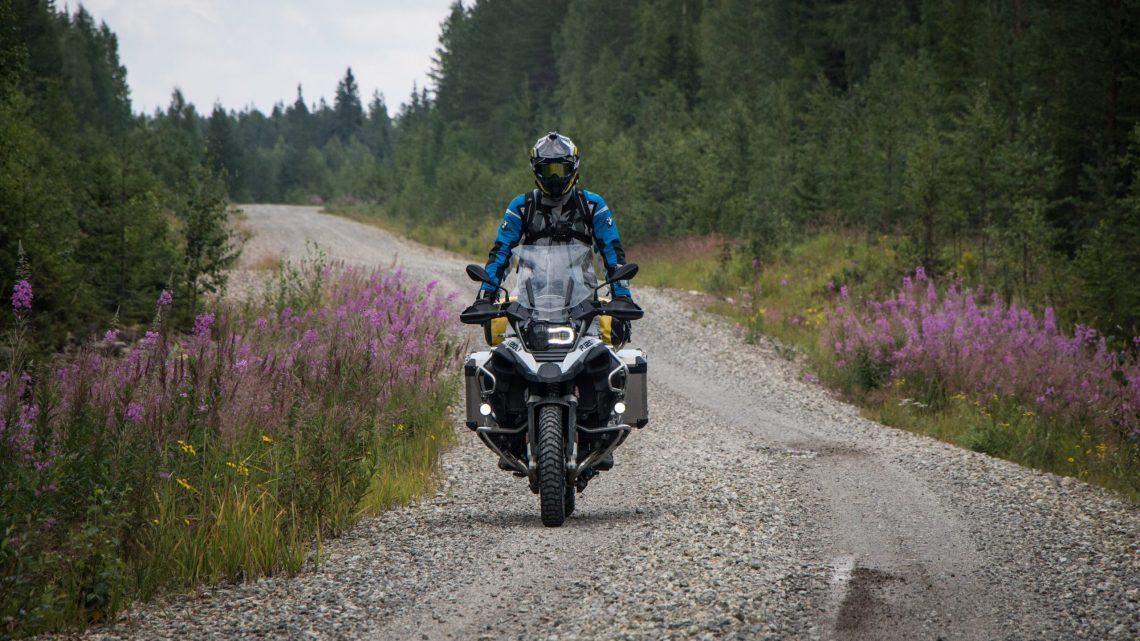
The Finnish TET
About 35 hours and 611 nautical miles later we arrived in Helsinki. We rode off the ferry and after a few miles on smaller roads, we quickly left Helsinki behind and started our journey on the Trans Euro Trail.
The TET, as it is widely known, stretches across most of Europe, including up the length of Finland, on unpaved roads and trails. We were facing the first off-road adventure of our lives. We set our bikes to Enduro mode and covered the first miles on gravel. From now on, we would only head in one direction, north!
Soon enough, we reached the Finnish Lake District which features more than 180,000 bodies of water. It is rich in moors and forests and covers an area of over 385,000 square miles. In this area, there were plenty of smaller side trails to explore, leading to numerous small bays, beaches and other hidden places waiting to be discovered. After the first 160 miles or so of riding through this stunning landscape, we stopped in the town of Tommolansalmi and pitched our tent for the first time on a small but inviting campsite.
As is the case on all our trips, we quickly divvied up the tasks to set up camp and we were ready to relax within minutes. We noticed how much we had missed this daily travel routine – setting up tents, getting into comfy clothes and being mesmerized by the beautiful landscape.
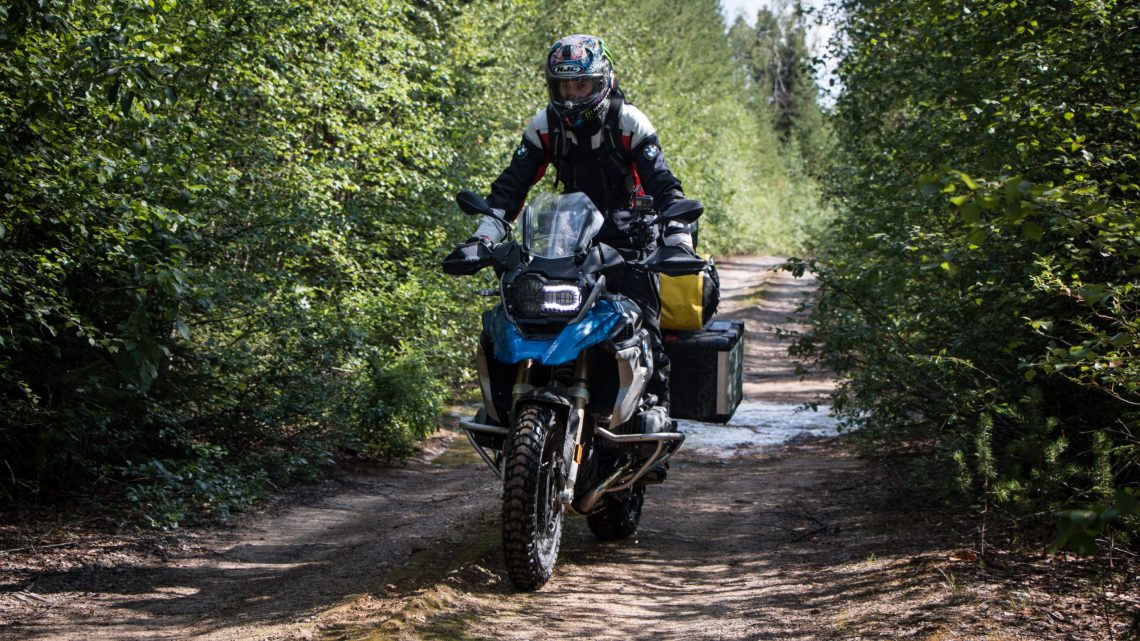
Gravel roads through untouched forestry
The following days were a blur of blue skies, sunshine and superb riding over countless gravel roads and trails through the untouched and remote forests of Finland. We were left speechless by the natural beauty of this vast country. We rode ever further north, past the town of Nurmes and onto the village of Vuokatti, finding a fantastic camp site next to a lake and so we went for a refreshing swim.
Although there were plenty of miles still between us and the Arctic Circle, the sun did not set below the horizon. The days were much longer than back home in Austria and we were able to enjoy basking in the sunshine at a jetty on the lake until 11pm, before it hid behind a hill.
The next section of our journey took us along the border of Finland and Russia. Museums and old war relics, including an old helicopter, were reminders of the conflict that took place in this area during World War Two.
Our route led us right through this historical terrain and past the winter sports resorts of Kuusamo and Rovaniemi. We had now arrived in Lapland, the land of reindeer and the midnight sun. Lapland’s climate is extreme.
Temperatures reach 30C in summer and well below -30C in the cold, dark winters. Further north, you need to keep a close eye on your fuel gauge as the distances between petrol stations grows longer and longer. After the town of Salla, there was no guaranteed fuel supply for the next 200 miles.

Summer in the arctic
After travelling further north, with plenty of photo stops and breaks to soak up our spectacular surroundings, we decided to take a shortcut marked on the navigation system. At first, everything seemed to meet our expectations, but the joy soon came to a sudden end.
Deep sand, mud and puddles forced us to turn around. It was 30 miles one-way off road and back again. Bathed in sweat and with nerves frayed, we eventually reached an asphalt road. That road was the most beautiful thing in the world to me at that moment (sorry Verena, but I know you felt the same).
Exhausted, we finally arrived in Levi, one of the biggest and best-known winter resorts in Finland. We felt it was time to have a bike-free day, so we swapped our motorcycle boots for hiking shoes and explored the area on foot.
We came skiing here two years ago and the difference between visiting in winter and summer is remarkable. In winter, the sun is rarely seen and even if it is, then only for what feels like a brief moment. In summer, it is the opposite, so we decided to go up the mountain for a midnight stroll and enjoy the sun. The view was breathtaking.
We enjoyed our day off but it was soon time to resume our journey. As we headed deeper into the Arctic Circle, we saw more and more wildlife crossing our path and plenty of signs warning us about moose in the area. We certainly didn’t want to end up hitting one of those huge animals.
Often, we caught ourselves simply marvelling at the vastness of the landscape and paying far too little attention to the road. We were reminded of the need to keep our wits about us when we were surprised by a herd of reindeer dashing across the road, unimpressed by the noise of our bikes.

Reaching Nordkapp
Continuing along gravel trails, our route led us to the village of Hetta, and from there, onto highway 93 to the Norwegian border. On the one hand we were happy to have ridden the length of Finland, but we were also a little bummed because the off-road riding we loved so much had come to an end. However, we didn’t feel down for long because we knew we were nearing our goal. Nordkapp was near!
We rode along the smooth surface of highway E45, past small lakes and rivers, north to the city of Alta. From here, it was only 150 miles to Nordkapp. Our final push took us along a dead-straight road through a barren landscape. Thankfully, from Olderfjord, the E69 turns into an unbelievable coastal road with spectacular views.
Around noon, we finally reached our destination, Nordkapp. It felt a little unreal. We had dreamed of reaching this point on our motorcycles for so long and now it was finally here. To the left and right of the road we could see countless reindeer going about their business.
Thankfully, there weren’t too many people around which meant we were able to enjoy the atmosphere in peace. It was a special moment for both of us. A short ride away, we pitched our tent at the northernmost campsite in the world, Kirkeporten Camping.
For us, it was the perfect starting point for the activities we had planned over the next two days, including the absolute highlight, the hike to the Knivskjelodden headland. This point is about a mile further north than Nordkapp, making it the actual northern endpoint of mainland Europe. The hike is quite long at around 12 miles, but it is not difficult or dangerous. The view onto Nordkapp plateau was simply breath-taking.
One thing we had to do of course was to take a photo with our motorcycles in front of the Nordkapp globe, the sculpture that has marked the end of so many journeys to this remote part of the world. However, there was a problem. As long as the gates are open to visitors, you aren’t allowed to drive up to the globe. That meant we could only take our photo between 1am and 6am. It was an early start but we took our chance to mark the grand finale of our adventure.

The Lofoten Islands
The following morning we packed our stuff and headed south, sad to be leaving Nordkapp behind, but happy to be continuing our adventure. The roads were empty and the surface was smooth as we rode towards the Norwegian city of Tromsø. I was enjoying the cool coastal air when I spotted something in the water.
“Verena! Whales!” I shouted over the intercom. What a spectacle. A herd of pilot whales was circling peacefully about 100m off the coast. The water was as smooth as glass and we watched them undisturbed for several minutes before they dove into the blue ocean again. It was a magnificent sight.
Shortly before we reached Tromsø, we caught a ferry and walked onto the deck to enjoy the fresh breeze. The warm temperatures made it feel more like being in Greece or Italy, than Norway.
Along the E8 and E10 highways, we finally came to the Lofoten archipelago. This world-famous collection of around 80 islands, the largest of which are connected by bridges or tunnels, is one of the most visited areas of Norway for a very good reason. The sight of the mountains towering more than 1,200m above the sea is breath-taking.
I couldn’t help but smile as a I rode passed charming fishing huts and along beautifully curving roads. After passing the towns and villages of Evenskjer, Svolvaer and Henningsvaer, we pitched our tent at a cosy campsite near the ferry port at Moskenes at the far end of Lofoten.
You could easily spend two weeks on the islands alone. Behind every bend is a picture-postcard view just waiting for you. Before we began our trip, friends had advised us to hike the popular Reinebringen trail. The view from this 442m-high peak overlooking the village of Reine is one of the most iconic in Lofoten.
Despite its popularity, you need to be fit to hike the trail. It leads you along a steep path, over boulders, through boggy earth and along intimidating cliff edges. The last ascent before the peak was exhausting and we were out of breath, but the view was worth the effort a thousand times over.

The FV17
On the day of our departure from Lofoten, we were rudely awoken by the loud scream of seagulls. As we opened the tent, we saw what had caused the ruckus. A fishing boat was returning to the harbour with a swarm of hungry seagulls in tow. Punctually, at 8am, our ferry left and we enjoyed a last glimpse on the islands from the ship.
Arriving in the port of Bodø, we were already looking forward to the next section of our journey. Earlier in the trip we had met Loke who was riding a Honda CBR 125. He told us not to ride on the main E6 highway, but to take the smaller FV17 to Steinkjer instead. Despite this adding a few miles to our journey, we made the decision to follow Loke’s advice and were rewarded with yet more spectacular views.
The road led us through numerous tunnels and six ferries as we passed through the stunning landscapes of Namdalen, Helgeland and Salten. The last few miles on the E6 before reaching the city of Trondheim turned out to be harder than expected through busy city traffic, so we were happy to finally reach the campsite. It was early afternoon and we spent the rest of the day exploring the city on foot.
The canal port area was created in the middle of the 19th century as part of a new harbour plan for the city. On the south side of the Kanalhavna, you will see the colourful Trondheim warehouses on the waterfront. In the centre of the city there is a marketplace where we delved into a huge street-food festival, sampling plenty of treats as we explored.
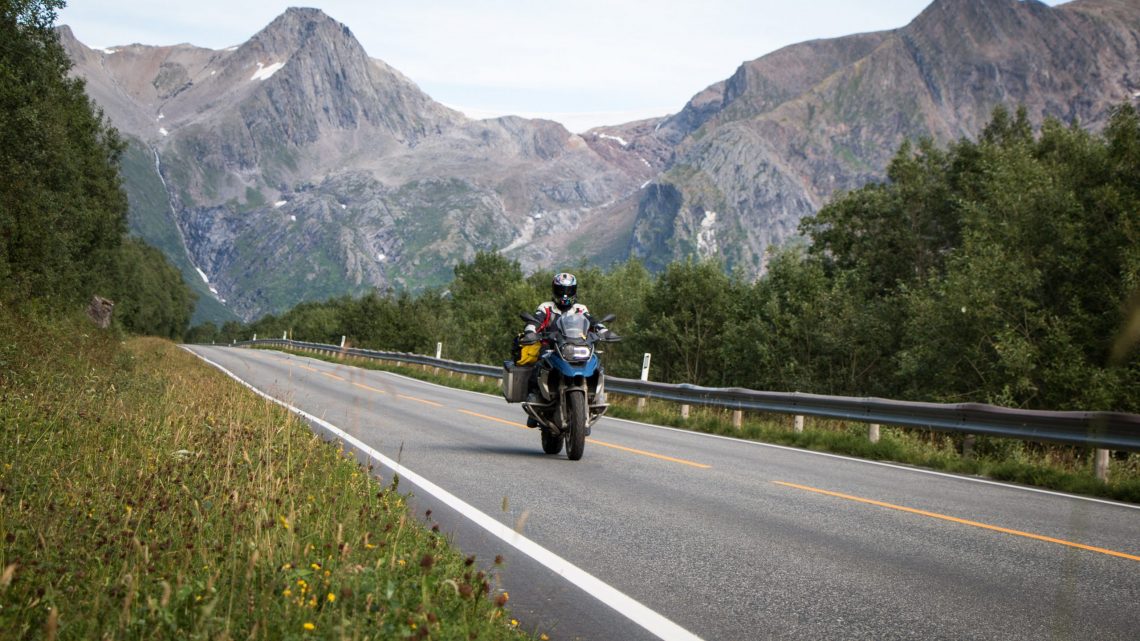
The Atlantic Ocean Road and Trollstigen
Around 135 miles from Trondheim is the Atlanterhavsvegen (Atlantic Ocean Road), Norway’s most famous road, which measures exactly 8,274m. It was a must-see attraction on our trip. The road features eight bridges linking several small islands and has become a world-famous tourist attraction, especially the famous Storseisundbrua Bridge, known for its distinctly curved shape. With a length of 260m and a height of 23m, it is the largest bridge on the Atlantic Road.
Another world-famous road we were excited to ride was just a short ride away, the mighty Trollstigen mountain pass. Fog hung in the air as we approached from the town of Andalsnes to the north, but it soon showed its best side.
From the Trollstigen, we followed highway 63 south. Past the breath-taking views of Tafjord and onto Geirangerfjord, which is a UNESCO World Heritage Site and one of the most beautiful fjords in Norway. The sight of the snowcapped mountains plunging into the water is truly special. We sat and watched one of the huge cruise ships manoeuvring its giant bulk to moor.
We continued on, riding to the mountain top of Dalsnibba, which is 1,476m high. The ride there was frustrating because it was littered with so many tourist coaches, but the view from the summit was compensation enough. Our eyes feasted on a grandiose view of the Geirangerfjord that lay around four miles away.
We decided to take advantage of the good weather and pushed on south to Jørpeland. This place is the starting point for many tourists who want to visit the famous Preikestolen (Preacher’s Chair), a steep cliff rising above a fjord with a large, flat summit. It made for yet another fantastic photo opportunity – Norway certainly has plenty of them.

Fjords round every corner
We pitched our tent on a camp site only a few miles away and set our alarm for 3am in order to experience the view at sunrise. The 2.5-mile trail led first up a steep ridge and along a path through a swampy forest. After about an hour, we reached the platform of the Preikestolen.
Only a few people, including those who had spent the night up there, enjoyed the uncanny silence and watched the sunrise. There was almost a meditative atmosphere as we felt the first rays of sunshine on our faces. The view into the Lysefjord was stunning and it was an unforgettable moment in our trip. From the Preacher’s Chair we rode to Oslo, the capital of Norway. We had planned to stay in a hotel as a reward for a previous exertions, but then we couldn’t resist the charm of the Ekeberg camp site.
The location offers a fantastic view over the whole of Oslo. We pitched our tent here for the remainder of our trip and, in great weather, we spent our last days sightseeing. Numerous sights, like the opera, the ski jump Holmenkollbakken and the ski museum, mean there is plenty to do if you have time to spare in Oslo. The Holmenkollen ski jump is considered the oldest ski jump in the world and in good weather conditions it also offers an excellent view over the capital. We will remember Oslo as a modern, progressive and lively city.
It was also the final destination on our trip. The journey to the North Cape and back had been an unforgettable experience and one of the most spectacular motorcycle rides of our lives. The sun shone brightly on that last day as we boarded a ferry at Oslo. It would take us to Kiel in Germany from where we would travel home to Vienna, Austria.
The seagulls screeched as the big diesel engines of the ColorLine ferry roared into life. We were both in a slightly melancholic mood. We enjoyed the cool sea breeze quietly one last time, reflecting on the many wonderful moments of our journey that were running through our minds.
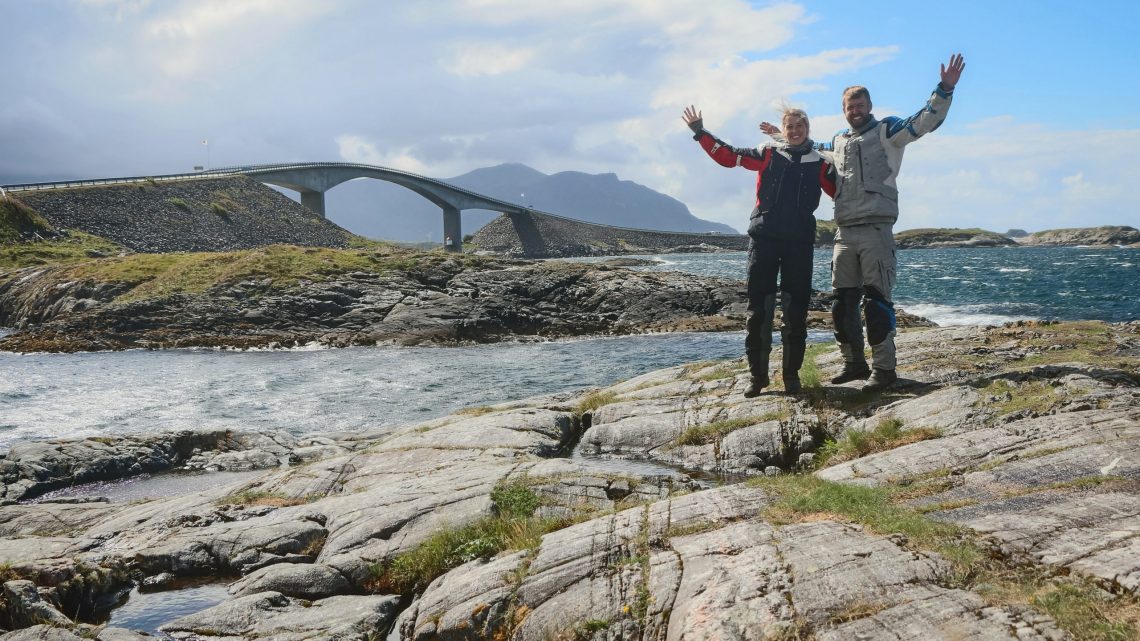
Who’s writing?
Verena and I live in Vienna and work as teachers in a primary and secondary school. This year we had our biggest adventure so far – our wedding. We’ve travelled to different parts of the world by bike for the last three years now. This has led us to Scotland, the North Cape and the Balkans.
We also do a lot of fly and ride tours around Europe and northern Africa. With our jobs, it is quite easy to plan a holiday, rent bikes and travel around for one or two weeks, since our holidays always overlap. After our first tours, we started our project World Spins As Fast As We Ride.
We post our pictures and videos on our website and social media channels, write travel reports, and help inform others planning trips like ours. Over the last couple of years, we have met so many wonderful people on our tours. All them, along with our friends and family, or those who write to us online, have shown us that travel is all about the people you meet.



